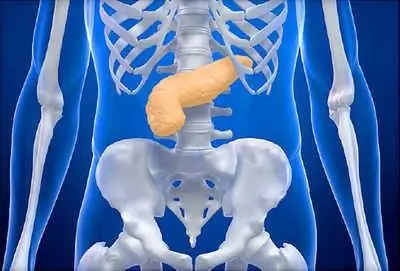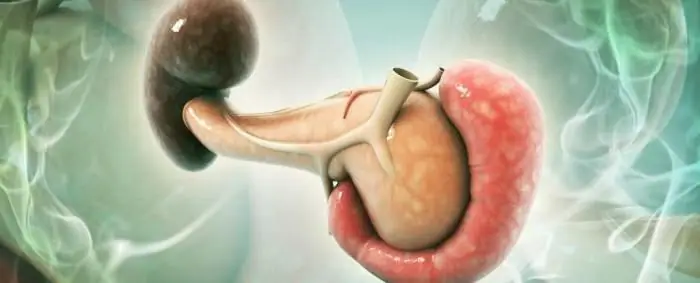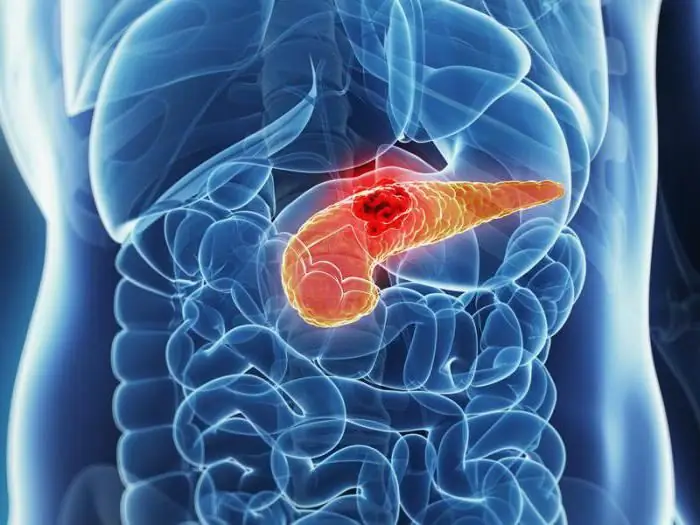- Author Curtis Blomfield [email protected].
- Public 2023-12-16 20:44.
- Last modified 2025-01-23 17:01.
Elastase-1 (pancreatic elastase-1) is a special enzyme produced by the pancreas. A study for the presence of this enzyme is carried out using biochemical analysis. This indicator has an independent diagnostic value, but is most often studied together with the determination of the level of amylase, KLA and a coprogram. The detection of the level of this indicator in the feces is used to assess the work of the pancreas. This analysis is performed by ELISA, using feces for it, which is collected in a sterile container. The normal rate for an adult ranges from 201 mcg / g. Sample testing can take anywhere from one to nine days.

What is elastase?
Elastase is an enzyme belonging to the group of hydrolases. Its molecular weight reaches 28,000 carbon units. Compared to other proteases, this enzyme is able to cleave the structural protein that makes up the elasticconnective tissue fibers, blood vessel walls, skin. Elastase comes in two forms - pancreatic and leukocyte.
Where is it synthesized?
Pancreatic elastase-1 is synthesized in the pancreas and then released as proelastase into the small intestine along with other enzymes. In the small intestine, under the action of serine protease, it is transformed into elastase. PE-1 is not broken down in the intestine, which is why its concentration in the feces is an indicator of the regulation of the amount and composition of pancreatic juice secreted by the pancreas.

What group does it belong to?
Together with chymotrypsin and trypsin, elastase belongs to the group of serine proteases. This is due to the fact that the active center contains serine. All the enzymes previously listed make up about 40% of the total concentration of proteins in the exocrine region in the pancreas. They all belong to the same family. PE-1 has a higher specificity than trypsin. Therefore, its activation occurs during the separation of peptide bonds formed by amino acids. Also, elastase is able to take part in the process of splitting the elastin protein, which does not decompose under the action of trypsin and chymotrypsin.
Determination of pancreatic elastase in feces is often used to diagnose cystic fibrosis. As a result of the disease cystic fibrosis, which is a genetic pathology, there is a violation in the structure and functionality of the cells that are locatedon the excretory ducts of the glands. Cystic fibrosis provokes damage to the lungs, stomach, kidneys, intestines. In this case, an analysis of pancreatic elastase will reveal a significant decrease in its fecal mass. The test for this indicator is a highly sensitive and specific research method that is widely used in gastroenterology, hepatology and endocrinology.

Indications for testing
An analysis to determine the level of pancreatic elastase-1 can be prescribed to determine the insufficiency of the secretory activity of the pancreas, in the diagnosis of cystic fibrosis, malignant neoplasms, pancreatitis in a chronic form. In addition, the study is indicated for monitoring the treatment of pancreatic insufficiency.
Study for pancreatic elastase (the norm will be presented below) may be ordered if the following symptoms are observed:
- Diarrhea or constipation.
- Intestinal bloating.
- Pain and heaviness in the abdomen after eating.
- Dramatic weight loss.
- Change in consistency, color and odor of feces.
- The presence of undigested food in the feces.

There are no contraindications to this test.
The specificity of the study of fecal mass for the content of elastase-1 in it can reach 95%, and the sensitivity is almost 93%. Another meritof this study - the low ability of pancreatic elastase-1 to split. This allows the material to be preserved for a long time, if all the conditions for its collection are met.
Preparing for the study and collecting material for it
For research it is necessary to take a sample of feces. It is preferable to take the test in the morning, between 7 am and 11 am. Before the study, food is allowed. This is due to the fact that elastase, which comes with food, is not destroyed in the intestine and cannot affect the result of the study. It is important not to take laxatives, not to use rectal suppositories and barium preparations for several days before the test. It is necessary to take an analysis before other manipulations such as enemas or colonoscopy will be carried out.
The conduct and results of the study on the content of elastase-1 in the feces are also not affected by drug treatment that involves taking pancreatic enzymes.

When collecting biomaterial, several rules should be observed. It is necessary to observe the sterility of the container and ensure that no urine enters the stool sample. Then you should transfer the stool sample to a special container in a volume of 30-60 milliliters and close it tightly with a lid. Until the time of sending the feces for examination, it should be stored in the refrigerator. The temperature should be between five and eight degrees. It is possible to collect feces for this study during the day, and if necessary, it can be frozen whentemperature -20 degrees.
Research method
When conducting the analysis, the enzyme immunoassay method is used. On a plastic plate for ELISA, the laboratory technician applies a layer of antibodies that can only recognize elastase-1. Then a sample of the studied biomaterial is attached to the antibodies. The biotin site is labeled with a dye. The color intensity of the marker is determined by spectrophotometry.
Normal indicators of the enzyme in the biomaterial
Elastase-1 levels in a newborn baby are slightly below normal, but by two weeks of age they reach normal levels. Only a highly qualified specialist should analyze the received data. The transcript of the results is as follows.

- EP value > 200 mcg/g indicates normal pancreatic function. The higher the value, the better the function of this organ (when pancreatic elastase > 500 mcg/g or just 500 is good).
- Value 100-200 mcg/g - mild pancreatic insufficiency.
- EP value <100mcg/g - moderate or severe organ failure.
That is, if the indicator is above the norm, it will not have any clinical significance. But when the study revealed an insufficient level of elastase, it is necessary to start treatment.






